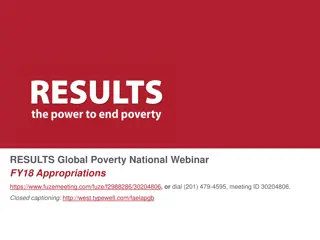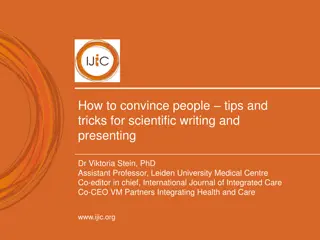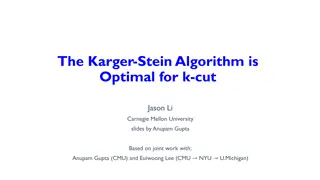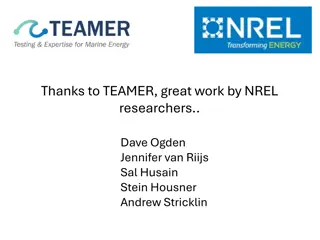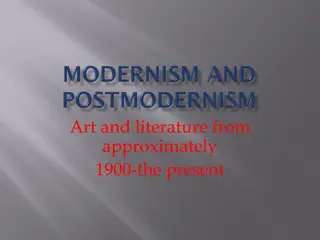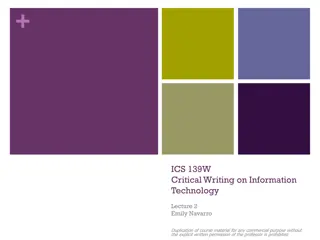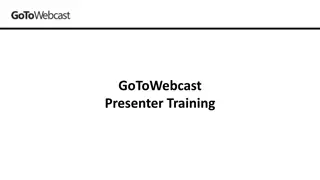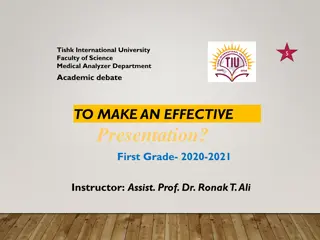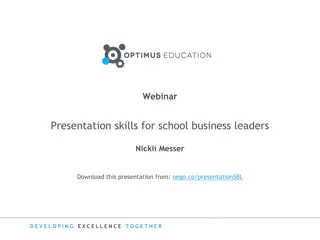
Child Sexual Offence Evidence Program in New South Wales
Child Sexual Offence Evidence Program (CSOEP) in New South Wales aims to support children in providing accurate evidence in cases of sexual offences, addressing the challenges they face as witnesses. The program includes pre-recorded evidence hearings and witness intermediaries to ensure fairness and protect vulnerable witnesses.
Download Presentation

Please find below an Image/Link to download the presentation.
The content on the website is provided AS IS for your information and personal use only. It may not be sold, licensed, or shared on other websites without obtaining consent from the author. If you encounter any issues during the download, it is possible that the publisher has removed the file from their server.
You are allowed to download the files provided on this website for personal or commercial use, subject to the condition that they are used lawfully. All files are the property of their respective owners.
The content on the website is provided AS IS for your information and personal use only. It may not be sold, licensed, or shared on other websites without obtaining consent from the author.
E N D
Presentation Transcript
Child Sexual Offence Evidence Program (CSOEP) New South Wales 1 Australasian Institute of Judicial Administration Conference Sydney August 3rd 2024 Judge Kate Traill District Court of New South Wales
Child sexual offence evidence Child sexual offence evidence It is well recognised that children face significant difficulties as complainants and witnesses in these cases due to their young age and the nature of the evidence they must give. Providing this evidence to police and the Court can be a highly stressful and traumatic experience. It is vital that these children are supported to give the most complete and accurate evidence they can. Attorney General Michael Daley Hansard, 20 September 2023
Child witnesses Child witnesses In its 1997 report Seen and Heard , the Australian Law Reform Commission said that the context between lawyer and child was an inherently unequal one . The Commission found that some child witnesses were often taken advantage of because they were easily confused and intimated; because they were unable to match the linguistic skills of experienced lawyers; and because, unlike the lawyer, they were in a hostile, alien environment . That inequality highlights the need to ensure fairness in examining a child witness. Ward (A Pseudonym) v The Queen[2017] VSCA 37 at [97].
Child Sexual Offence Evidence Legislative History Child Sexual Offence Evidence Legislative History 1. The CSOEP commenced in 2016. 2. A pilot scheme operated in Sydney and Newcastle District Courts, and South-Western and Metropolitan and Hunter Child Abuse Units. 3. On 10 October 2023, the Criminal Procedure Amendment (Child Sexual Offence) Act 2023 was passed by NSW Parliament. 4. The legislation commenced on 29 January 2024, and rolls out the CSOEP across NSW to all NSW Police Force Child Abuse Units and all NSW District Courts. 5. The legislation is located at Chapter 6, Part 5, Division 1A of the Criminal Procedure Act see s 294E to s 294S. 4
Key amendments Key amendments Pre Pre- -recorded evidence hearings recorded evidence hearings: Pre-recorded evidence hearings occur before trial and as soon as practicable in the District Court. Examination in chief tended the child s interview (s 306U). Further evidence in chief, cross-examination and re-examination to occur at the pre-recorded hearing. Witnesses may only give further evidence at trial with leave. Witness intermediaries Witness intermediaries: Witness intermediaries are available both at the police investigative stage and in court to assist with the child s communication needs. 5
Why CSOEP? Why CSOEP? Best evidence = a fair trial Best evidence = a fair trial Child witnesses are vulnerable witnesses. One of the principles of the criminal justice system is to ensure fairness, and this includes facilitating the participation of vulnerable child witnesses and providing a capacity for them to give their best evidence. This participation includes the Court giving directions for the appropriate treatment and questioning of child witnesses. WI schemes and pre-recordings aim to facilitate child witnesses to give their best evidence in light of research and experience, particularly in England and Wales since 2008, which shows that the way in which questions are asked of the witness can affect their evidence. 6
The legislation The legislation A snapshot A snapshot 294 294F F Application Application of of Division The Division applies to a child witness in Court hearing for a prescribed sexual assault matter committed from 29 January 2024 committed from 29 January 2024. Applies to all children under 18 years Across all district courts Only prosecution witnesses Division Section 294H Section 294H Timing of the PRH Timing of the PRH A pre-recorded evidence hearing should take place as soon as practicable after the matter s first appearance in the District Court (usually within 2-3 months. A PRH is the start of the trial. It is important to identify all pre-trial issues prior to the commencement of the PRH. 7
A witness whose evidence is pre-recorded must not give further evidence without leave of the Court. An application for leave may be made by any party. The Court must not give leave unless satisfied: That the party is seeking leave because of becoming aware of a matter which the party could not reasonably have been aware at the time of the recording, or It is otherwise in the interests of justice to do so. See WX v R [2020] NSWCCA 142 and PJ v R [2023] NSWCCA 105. Section Section 294K 294K Witness may Witness may give further give further evidence evidence only with only with leave leave 8
A witness intermediary is appointed to assist communication with the child. Section Section 294L and M 294L and M Witness Witness Intermediary Intermediary The witness intermediary is appointed for children under 16 years and 16-18 years if they have difficulty communicating The court can request a witness intermediary report for anyone 16-18 to ascertain communication difficulty and the need for a witness intermediary role role 9
What is a Ground Rules Hearing? A Ground Rules Hearing (GRH) is a pre-trial listing usually one week before the pre-recorded hearing. A discussion between the Judge, Counsel and the witness intermediary regarding the witness s communication needs and any other arrangements to be made. Witness intermediary is not affirmed. Parties are encouraged to discuss the best approach for questioning the child 10
What happens at a pre What happens at a pre- -recorded evidence hearing? recorded evidence hearing? The pre-recorded hearing is the start of the trial; the accused is arraigned The witness intermediary and child appear via AVL from a remote witness room with a support person The Crown, Defence, and accused person appear in person (or via AVL if necessary). Prior to the commencement of the PRH, the presiding judge will introduce themselves and the parties to the child, and take them through the rules of court . 11
What happens at a pre What happens at a pre- -recorded evidence hearing? recorded evidence hearing? The rules of court include: Breaks If you don t understand the question, let the Court or WI know Don t feel any pressure to agree to a question just because an adult is asking the question It is important to tell the truth and only talk about things that really happened Don t guess at an answer. If you can t remember or you don t know the answer, you can tell the Court If you hear the words I object don t answer the question What are Exhibits/MFIs The formula for Browne v Dunn questions 12
What happens at a pre What happens at a pre- -recorded evidence hearing? recorded evidence hearing? Evidence in chief Evidence in chief Typically short JIRT interview is not played in Court during PRH. The child witness watches the JIRT the day before at the ODPP office. The disc and transcript are marked for identification. If the child witness has given a statement instead of a JIRT, XN is adduced in the usual way. Cross Cross- -examination examination Proceeds in accordance with the recommendations in the witness intermediary report The witness intermediary will interject (if required) by raising their hand. 13
Advocates must adapt to the witness. Not the other way around. Lady Justice Hallet, Vice President of the Court of Appeal UK 14
Effective Communication with Vulnerable Children and Adults: The Role of the Witness Intermediary Rukiya Stein Accredited Witness Intermediary, NSW Independent Communication Intermediary Speech and Language Pathologist PhD Candidate in Law Australasian Institute of Judicial Administration Conference Sydney August 3rd 2024
Barriers to Effective Participation and Communication Sensory issues, e.g., lighting, noise, the feel of the chair, etc. Unfamiliarity with the process of giving evidence Receptive language difficulties Expressive language difficulties Memory impairments Can t show emotions May have inappropriate expressions or behaviours Difficulty with tone of voice Literal Mental health issues Trauma Can t ask for breaks independently Autism Attention Deficit Hyperactivity Disorder (ADHD) Intellectual Disability
WITNESS INTERMEDIARIES 18 Facilitate two-way communication between the vulnerable person and legal professionals to enable the vulnerable person to provide complete, coherent and accurate evidence.1 1. Penny Cooper, Highs and Lows: The 4thIntermediary Survey (2014) Kingston University London.
Witness Intermediaries are NOT 19 A Support person An Interpreter An expert witness A Victim s advocate An Interviewer or second interviewer A questioner at court
Intermediaries in Australia 20 Western Australia- the first intermediary scheme in 1992, but has not been widely used; no formal scheme yet. New South Wales- 2016- 2019- pilot to program Victoria- 2018 ACT- 2020- has the broadest legislation Tasmania- March 2021 Queensland- July 2021 South Australia- Communication Partner Scheme Northern Territory- No scheme
The Intermediary Role Comprehensive assessment report written Dissemination of report to referring legal agency (prosecution, defence) and judge if requested Communication assessment Attend Facilitate communication at the Pre-Recorded Hearing or Trial Ground Rules Hearing
Common Intermediary Recommendations 22 Use timelines for sequencing of alleged incidents and temporal questions Use simple questions with a question word (wh and auxiliary) Provide the witness time to respond; avoid rapid questioning Use simple vocabulary and the witness language (e.g. for the accused and body parts) Signpost topic changes- use coloured post-it notes Use visual communication aids
Why do we intervene? Conventional cross-examination contravenes almost every principle for obtaining complete and accurate reports fromchild witnesses - R Zajac (2009) Complex vocabulary or legalese Tag questions Statements as questions Idiomatic language, e.g. let me jog your memory . Unnecessary preamble before a question Complex propositions with tags and double negatives Child or adult needs a break/ becomes distressed Multiple questions
Confusing Questions: Tag Questions 24 1. Statements that tag a question at the end At the beginning Would you agree that you never told the police you went to his house alone? In the middle You just told us, didn t you, that you could not remember what time you left his house, but now you are saying it was definitely at 9pm? At the end (most common) You are not telling the truth, are you? He did not push you into the bedroom, did he?
Alternatives Q: Would you agree that you never told the police you went to his house alone? Did you ever go to his house alone? Q: You just told us, didn t you, that you could not remember what time you left his house, but now you are saying it was definitely at 9pm? What time did you leave his house? Was is definitely at 9pm? Q: You are not telling the truth, are you? Are you telling the truth? Q: He did not push you into the bedroom, did he? (proposition) He did not push you into the bedroom, agree or disagree?
Confusing Questions 26 Do you remember ? Do you remember how he pushed you into the bedroom? Do you know ? Do you know what you were doing before John came into the lounge room? Can you ? Can you tell us why you didn t struggle when John got on top of you?
Alternatives 27 Do you remember how he pushed you into the bedroom? How did he push you into the bedroom? Do you know what you were doing before John came into the lounge room? What were you doing before John came into the lounge room? Can you tell us why you didn t struggle when John got on top of you? Why didn t you struggle when John got on top of you?
Confusing Questions 28 8. Propositions/ Browne v Dunn John didn t have sex with you the first time you went to his house, did he? It isn t true that John forced himself on top of you in the bedroom? You never told John that you didn t want to have sex with him, did you?*
Visual Aids 29 2
FINAL THOUGHTS 30 No ONE person will be the same ADAPT YOUR PRACTICE TO SUIT THE PERSON, NOT THE DIAGNOSIS/ AGE/ DISABILITY THE BEST PRACTICE IS A PERSON- CENTERED PRACTICE Thank you Rukiya Stein articulatemenow@gmail.com






